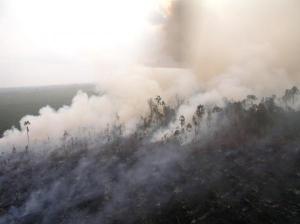A recent report by Reuters highlighted in Mongabay.com about forest fires in Peninsular Malaysia and Sumatra reminded me of an important paper that appeared in Nature in 2007.
Lohman and colleagues’ paper entiled The burning issue gets my vote for a Potential spot at ConservationBytes.com.
Let’s face it, there is ample evidence now that countries in Southeast Asia can ill-afford any more deforestation, yet unregulated and illegal burning continues there despite international accords to reduce the intensity and frequency of fires. Lohman et al. highlighted how farmers throughout Indonesia and Malaysia in particular are ignoring fire bans and continuing to apply traditional techniques of burning off vegetation from plantations when new crops are to be seeded.
Common practice, been used for centuries – so what? Well the problem is that many of these fires burn out of control for weeks to months and continue into the remaining fragmented forests adjacent to agricultural land. With already altered moisture regimes from logging and agricultural clearing, drier forests are more susceptible, leading to broad scale fires that further threaten these important biodiversity hotspots.
If you are of the blinkered type that couldn’t give a rat’s bollocks about the loss of species (I hope not – otherwise you probably wouldn’t be reading this), then the human cost should convince you that something drastic needs to be done. These rampant and seemingly unending fire cycles cost billions to some of the world’s poorest nations in terms of material damage. Additionally, the haze associated with fires (remember the 1998 El Niñ0 event that saw 3 million km2 of Southeast Asia covered in haze affecting 70 million people?) is a major health hazard that cripples and kills hundreds of thousands of people.
For my Australian readers, don’t think this is restricted to Southeast Asia – burning is a major biodiversity and human health hazard here as well (see Johnston et al. 2002, 2007, Woinarksi 1999 and Pardon et al. 2003)
Clearly the burning has to stop.














Hey Dr B
Good to see you’re talking fires…
As you know burning issues are complex, but just to make sure the right message gets out to your readers:
Clearly THIS TYPE OF burning has to stop.
Envious of your walk past EO’s office!
Kate
LikeLike
Hello Kate,
Indeed, I should have specified. It is the type (and often severity and frequency) that we modify to the detriment of biodiversity. Of course, in many systems, fire is absolutely essential.
LikeLike